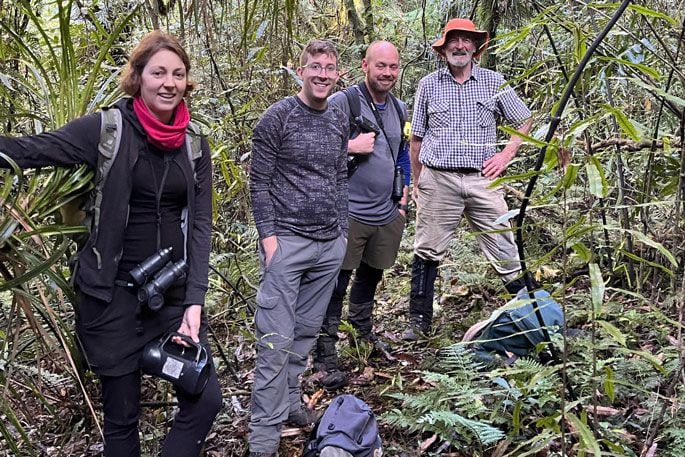Bay of Plenty conservation workers are celebrating what they describe as an “incredible achievement” in lifting numbers of an endangered bird in a forest in the region.
The number of kōkako in the Ōtanewainuku Conservation Area has increased by 44 in the last four years, according to Ōtanewainuku Kiwi Trust, which recently conducted a survey of the species.
Trust spokeswoman Tiffany Randell says the final tally from the survey completed on August 10 found 113 kōkako in the forest’s Conservation Area – this included 51 breeding pairs and 11 singles in the forest area above Ōropi.
“As you can imagine we are thrilled with this result, especially on the back of the national kōkako hui last month where a number of sites are recording a decline in kōkako populations,” says Tiffany.
The survey was funded by a Lotto NZ grant, and Western Bay of Plenty District and Bay of Plenty Regional councils contributed by supporting the trust’s pest control programme.
“The increase [in kokako numbers] is a big reward for our dedicated trappers and toxin teams and the tens of thousands of volunteer hours dedicated annually. We are so very proud to share this incredible achievement with the community,” says Tiffany.
Hans Pendergrast has lived in Ōtanewainuku Forest all his life and says it’s the volunteers who deserve the accolades.
Hans Pendergrast has lived in Ōtanewainuku Forest all his life and says it’s the volunteers who deserve the accolades. Photo: supplied.
“There were kōkako everywhere in the forest when I was a child. I would see them while out pig hunting with my father in the late 1950s and 1960s,” says Hans.
“Since then rats and possums not only affected their food supply, but they also ate every egg and chick.
“Stoats eat female birds that are defending their nests, as well as the chicks, so by the 2000s there were no kōkako left here.”
Hans says intensive and effective pest control across the 1200-hectare conservation area – like traps and bait stations – have allowed reintroduced kōkako to thrive.
“We are extremely proud and grateful to the volunteers who work tirelessly to help. I’m 73 years old and I’m in such a privileged position to be able to see kōkako restored in Ōtanewainuku to where they were when I was a child.
“This has been a mammoth task but we need to keep the pedal to the metal and keep working hard to protect this endangered species.”
If locals want to hear the distinctive song of the kōkako, Hans recommends they try the Rimu Walk or the Waterfall Walk early in the morning.
“There’s a saying amongst kōkako people that ‘if you go through life without seeing a kōkako that’s okay, as they are very difficult to spot in the forest. However, if you go through life without hearing a kōkako, you’ve missed one of the world’s great songs’.”
Those keen to volunteer or donate to Ōtanewainuku Kiwi Trust’s conservation work, visit: https://kiwitrust.org/

Census team member Amanda Rogers, OKT volunteer Andrew Simmons, census team member Mark Fisk, and OKT volunteer Hans Pendergrast in Ōtanewainuku Forest. Photo: Emily Malthus.



0 comments
Leave a Comment
You must be logged in to make a comment.